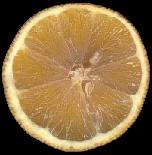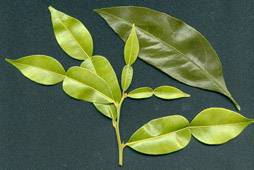


Although the nurseryman in Tunisia, where I obtained this variety, called it in French
'Citron Doux' (Sweet Lemon), I believe it is the Mediterranean Sweet Limetta
described in The Citrus Industry, Volume 1. In France this variety is known
as 'a Mamelon' which aptly describes the shape of the end of the fruit. |
The photos show a ripe fruit, about 3.5cms across, together with an immature fruit
showing its distinctive shape. The taste to me is initially lightly perfumed,
sweet and insipid, but with a slight bitter aftertaste which remains in the mouth
for some time. |

The 'Papeda' group of the citrus family are wild varieties that are generally too
bitter to be edible. Citrus Ichangensis, from China, is the most Northerly occuring
of all true citrus. It can be grown outdoors in the very mildest parts of
Britain. My plant originated from a cutting of the plant growing in the Ventnor
Botanic Gardens on the Isle of Wight (just off the South coast of England). There is a hybrid known as Ichang Lemon in USA which is said to be edible, but my plant produces fruit which contain just a mass of large pips and stringy pith. |
The picture above compares a clementine leaf with a twig of the Ichang Papeda. The
leaves are very similar to the tropical Thai Lime (Citrus Hystrix). Flowers grow
singly at the junction of leaf and stalk. |

Citrus Ichangensis Flower - about 3.5cms across. Notice how the stamens are fused together to form a central tube. On my plant the flowers always seem to have a drop of water within this tube, making the pollen wet - even though watering has only been to the soil. |
page updated 4th Oct 05 |





Immature fruits have a very distinctive pebble surface texture, which disappears as
they ripen from dark green to yellow. The riper fruit (right) is about 5cms x 4cms |
The fruits contain no edible flesh, just pith and very large seeds, about 13mm in
diameter. |



This exact parentage of this variety is not certain, but thought to be Eremocitrus glauca x Meyers lemon. If so it is actually a mixture of three varieties, as Meyers lemon
is itself believed to be an orange x lemon. |
Note the long stalks on the flower buds. Fully grown leaves are about 6cms by 1cm. The fruit, the only one produced in 2003, is about 1.5cms diameter. |